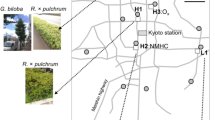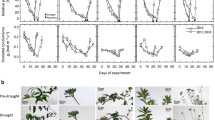Abstract
Key message
Seasonal variations in the leaf photosynthetic traits of an urban tree, Ginkgo biloba, were almost synchronized with the photoperiod. Non-stomatal limitations were a cue for photosynthesis in Ginkgo biloba.
Photosynthetic functions, which are key traits in determining the carbon uptake of urban trees, exhibit significant seasonal variations in temperate zones. It is essential to clarify the seasonal dynamics of photosynthesis to evaluate the CO2 uptake in urban areas. We investigated seasonal variations in the photosynthetic traits of Ginkgo biloba, which is a major urban deciduous tall tree often planted in Japan. Seasonal variations in the leaf photosynthetic traits, including the maximum photosynthesis rate, maximum carboxylation rate, and mesophyll and stomatal conductance, were well fitted to quadratic models, in which they peaked around the summer solstice and then declined with time. Seasonal variations in the environmental variables, such as photoperiod, temperature, and solar radiation, were compared to those of the leaf photosynthetic traits, in which the photoperiod explained well variations in the leaf photosynthetic traits. Seasonal variations in photosynthesis were largely governed by non-stomatal limitations, i.e., mesophyll and biochemical limitations. The high synchrony of the photoperiod and photosynthetic traits during leaf maturation may cause an enhancement in the daily carbon uptake of G. biloba leaves around the summer solstice, which has the longest photoperiod, and thus, will lead to an increase in the annual carbon uptake.





Similar content being viewed by others
Change history
15 September 2021
A Correction to this paper has been published: https://doi.org/10.1007/s00468-021-02213-9
References
Angert A, Biraud S, Bonfils C, Henning CC, Buermann W, Pinzon J, Tucker CJ, Fung I (2005) Drier summers cancel out the CO2 uptake enhancement induced by warmer springs. Proc Natl Acad Sci 102:10823–10827. https://doi.org/10.1073/pnas.050164710210.1073/pnas.0501647102
Basler D, Körner C (2014) Photoperiod and temperature responses of bud swelling and bud burst in four temperate forest tree species. Tree Physiol 34:377–388. https://doi.org/10.1093/treephys/tpu021
Bauerle WL, Oren R, Way DA, Qian SS, Stoy PC, Thornton PE, Bowden JD, Hoffman FM, Reynolds RF (2012) Photoperiodic regulation of the seasonal pattern of photosynthetic capacity and the implications for carbon cycling. Proc Natl Acad Sci 109:8612–8617. https://doi.org/10.1073/pnas.1119131109
Becker P, Tyree MT, Tsuda M (1999) Hydraulic conductances of angiosperms versus conifers: similar transport sufficiency at the whole-plant level. Tree Physiol. https://doi.org/10.1093/treephys/19.7.445
Broeckx LS, Fichot R, Verlinden MS, Ceulemans R (2014) Seasonal variations in photosynthesis, intrinsic water-use efficiency and stable isotope composition of poplar leaves in a short-rotation plantation. Tree Physiol 34:701–715. https://doi.org/10.1093/treephys/tpu057
Busch F, Hüner NPA, Ensminger I (2007) Increased air temperature during simulated autumn conditions does not increase photosynthetic carbon gain but affects the dissipation of excess energy in seedlings of the evergreen conifer jack pine. Plant Physiol 143:1242–1251. https://doi.org/10.1104/pp.106.092312
Caffarra A, Donnelly A (2011) The ecological significance of phenology in four different tree species: effects of light and temperature on bud burst. Int J Biometeorol 55:711–721. https://doi.org/10.1007/s00484-010-0386-1
Cai ZQ, Schnitzer SA, Bongers F (2009) Seasonal differences in leaf-level physiology give lianas a competitive advantage over trees in a tropical seasonal forest. Oecologia 161:25–33. https://doi.org/10.1007/s00442-009-1355-4
Damatta FM, Godoy AG, Menezes-Silva PE, Martins SCV, Sanglard LMVP, Morais LE, Torre-Neto A, Ghini R (2016) Sustained enhancement of photosynthesis in coffee trees grown under free-air CO2 enrichment conditions: Disentangling the contributions of stomatal, mesophyll, and biochemical limitations. J Exp Bot 67:341–352. https://doi.org/10.1093/jxb/erv463
Dreyer E, Le Roux X, Montpied P, Daudet FA, Masson F (2001) Temperature response of leaf photosynthetic capacity in seedlings from seven temperate tree species. Tree Physiol 21:223–232. https://doi.org/10.1093/treephys/21.4.223
Escobedo F, Varela S, Zhao M, Wagner JE, Zipperer W (2010) Analyzing the efficacy of subtropical urban forests in offsetting carbon emissions from cities. Environ Sci Policy 13:362–372. https://doi.org/10.1016/j.envsci.2010.03.009
Ethier GJ, Livingston NJ (2004) On the need to incorporate sensitivity to CO2 transfer conductance into the Farquhar-von Caemmerer-Berry leaf photosynthesis model. Plant Cell Environ 27:137–153. https://doi.org/10.1111/j.1365-3040.2004.01140.x
Ethier GJ, Livingston NJ, Harrison DL, Black TA, Moran JA (2006) Low stomatal and internal conductance to CO2 versus Rubisco deactivation as determinants of the photosynthetic decline of ageing evergreen leaves. Plant Cell Environ 29:2168–2184. https://doi.org/10.1111/j.1365-3040.2006.01590.x
Goulden ML, Munger JW, Fan S-M, Daube BC, Wofsy SC (1996) Exchange of carbon dioxide by a deciduous forest: response to interannual climate variability. Science (80) 271:1576–1578. https://doi.org/https://doi.org/10.1126/science.271.5255.1576
Grassi G, Magnani F (2005) Stomatal, mesophyll conductance and biochemical limitations to photosynthesis as affected by drought and leaf ontogeny in ash and oak trees. Plant Cell Environ 28:834–849. https://doi.org/10.1111/j.1365-3040.2005.01333.x
Iio A, Yokoyama A, Takano M, Nakamura T, Fukasawa H, Nose Y, Kakubari Y (2008) Interannual variation in leaf photosynthetic capacity during summer in relation to nitrogen, leaf mass per area and climate within a Fagus crenata crown on Naeba Mountain, Japan. Tree Physiol 28:1421–1429. https://doi.org/10.1093/treephys/28.9.1421
Iizuka Y, Funakubo S (2018) The roadside trees of Japan VIII. National Institute for Land and Infrastructure Management, Ministry of Land, Infrastructure, Transport and Tourism, Japan
Jo HK (2002) Impacts of urban greenspace on offsetting carbon emissions for middle Korea. J Environ Manag 64:115–126. https://doi.org/10.1006/jema.2001.0491
Jochner S, Menzel A (2015) Urban phenological studies: past, present, future. Environ, Pollut
Kagotani Y, Fujino K, Kazama T, Hanba YT (2013) Leaf carbon isotope ratio and water use efficiency of urban roadside trees in summer in Kyoto city. Ecol Res 28:725–734. https://doi.org/10.1007/s11284-013-1056-7
Kagotani Y, Nishida K, Kiyomizu T, Sasaki K, Kume A, Hanba YT (2016) Photosynthetic responses to soil water stress in summer in two Japanese urban landscape tree species (Ginkgo biloba and Prunus yedoensis): effects of pruning mulch and irrigation management. Trees Struct Funct. https://doi.org/10.1007/s00468-015-1312-2
Kanda Y (2013) Investigation of the freely available easy-to-use software “EZR” for medical statistics. Bone Marrow Transplant 48:452–458. https://doi.org/10.1038/bmt.2012.244
Kataoka K, Matsumoto F, Ichinose T, Taniguchi M (2009) Urban warming trends in several large Asian cities over the last 100 years. Sci Total Environ 407:3112–3119. https://doi.org/10.1016/j.scitotenv.2008.09.015
Kiyomizu T, Yamagishi S, Kume A, Hanba YT (2019) Contrasting photosynthetic responses to ambient air pollution between the urban shrub Rhododendron × pulchrum and urban tall tree Ginkgo biloba in Kyoto city: stomatal and leaf mesophyll morpho-anatomies are key traits. Trees 33:63–77. https://doi.org/10.1007/s00468-018-1759-z
Kordowski K, Kuttler W (2010) Carbon dioxide fluxes over an urban park area. Atmos Environ 44:2722–2730. https://doi.org/10.1016/j.atmosenv.2010.04.039
Körner C, Basler D (2010) Phenology under global warming. Science (80) 327:1461–1462. https://doi.org/https://doi.org/10.1126/science.1186473
Kosugi Y, Shibata S, Kobashi S (2003) Parameterization of the CO2 and H2O gas exchange of several temperate deciduous broad-leaved trees at the leaf scale considering seasonal changes. Plant Cell Environ 26:285–301. https://doi.org/10.1046/j.1365-3040.2003.00960.x
Kuittinen M, Moinel C, Adalgeirsdottir K (2016) Carbon sequestration through urban ecosystem services. Sci Total Environ 563–564:623–632. 1https://doi.org/https://doi.org/10.1016/j.scitotenv.2016.03.168
Matsumoto K, Iohta T, Irasawawa M, Nakamura T (2003) Climate change and extension of the Ginkgo biloba L. growing season in Japan. Glob Chang Biol 9:1634–1642. https://doi.org/10.1046/j.1529-8817.2003.00688.x
McCarthy MP, Best MJ, Betts RA (2010) Climate change in cities due to global warming and urban effects. Geophys Res Lett 37:1–5. https://doi.org/10.1029/2010GL042845
Meineke E, Youngsteadt E, Dunn RR, Frank SD (2016) Urban warming reduces aboveground carbon storage. Proc R Soc B Biol Sci 283:20161574. https://doi.org/10.1098/rspb.2016.1574
Misawa A, Hi T (1990) Effect of street lightnings on the time of leaf fall of roadside trees. J Jpn Inst Landsc Archit 53:17–132. https://doi.org/10.5632/jila1934.53.5_127
Muraoka H, Saigusa N, Nasahara KN, Noda H, Yoshino J, Saitoh TM, Nagai S, Murayama S, Koizumi H (2010) Effects of seasonal and interannual variations in leaf photosynthesis and canopy leaf area index on gross primary production of a cool-temperate deciduous broadleaf forest in Takayama, Japan. J Plant Res 123:563–576. https://doi.org/10.1007/s10265-009-0270-4
Nasahara KN, Muraoka H, Nagai S, Mikami H (2008) Vertical integration of leaf area index in a Japanese deciduous broad-leaved forest. Agric For Meteorol 148:1136–1146. https://doi.org/10.1016/j.agrformet.2008.02.011
Nowak DJ, Crane DE (2002) Carbon storage and sequestration by urban trees in the USA. Environ Pollut 116:381–389. https://doi.org/10.1016/S0269-7491(01)00214-7
Ögren E, Evans JR (1993) Photosynthetic light-response curves. Planta 189:182–190. https://doi.org/10.1007/BF00195075
Osone Y, Kawarasaki S, Ishida A, Kikuchi S, Shimizu A, Yazaki K, Aikawa S, Yamaguchi M, Izuta T, Matsumoto GI (2014) Responses of gas-exchange rates and water relations to annual fluctuations of weather in three species of urban street trees. Tree Physiol 34:1056–1068. https://doi.org/10.1093/treephys/tpu086
Park CK, Ho CH, Jeong SJ, Lee EJ, Kim J (2017) Spatial and temporal changes in leaf coloring date of Acer palmatum and Ginkgo biloba in response to temperature increases in South Korea. PLoS ONE 12:1–18. https://doi.org/10.1371/journal.pone.0174390
Parry C, Blonquist JM, Bugbee B (2014) In situ measurement of leaf chlorophyll concentration: analysis of the optical/absolute relationship. Plant Cell Environ 37:2508–2520. https://doi.org/10.1111/pce.12324
Qiu C, Ethier G, Pepin S, Dubé P, Desjardins Y, Gosselin A (2017) Persistent negative temperature response of mesophyll conductance in red raspberry (Rubus idaeus L.) leaves under both high and low vapour pressure deficits: a role for abscisic acid? Plant Cell Environ 40:1940–1959. https://doi.org/10.1111/pce.12997
Reynolds RF, Bauerle WL, Wang Y (2009) Simulating carbon dioxide exchange rates of deciduous tree species: evidence for a general pattern in biochemical changes and water stress response. Ann Bot 104:775–784. https://doi.org/10.1093/aob/mcp156
Schneider CA, Rasband WS, Eliceiri KW (2012) NIH Image to ImageJ: 25 years of image analysis. Nat Methods 9:671–675. https://doi.org/10.1038/nmeth.2089
Shi D, Wei X, Chen G, Xu Y (2012) Changes in photosynthetic characteristics and antioxidative protection in male and female ginkgo during natural senescence. J Am Soc Hortic Sci 137:349–360. https://doi.org/10.21273/jashs.137.5.349
Šmarda P, Horová L, Knápek O, Dieck H, Dieck M, Ražná K, Hrubík P, Orlóci L, Papp L, Veselá K, Veselý P, Bureš P (2018) Multiple haploids, triploids, and tetraploids found in modern-day “living fossil” Ginkgo biloba. Hortic Res. https://doi.org/10.1038/s41438-018-0055-9
Tayasu I, Hirasawa R, Ogawa NO, Ohkouchi N, Yamada K (2011) New organic reference materials for carbon- and nitrogen-stable isotope ratio measurements provided by Center for Ecological Research, Kyoto University, and Institute of Biogeosciences, Japan Agency for Marine-Earth Science and Technology. Limnology 12:261–266. https://doi.org/10.1007/s10201-011-0345-5
Terashima I, Ono K (2002) Effects of HgCl2 on CO2 dependence of leaf photosynthesis: evidence indicating involvement of aquaporins in CO2 diffusion across the plasma membrane. Plant Cell Physiol 43:70–78. https://doi.org/10.1093/pcp/pcf001
Turnbull MH, Murthy R, Griffin KL (2002) The relative impacts of daytime and night-time warming on photosynthetic capacity in Populus deltoides. Plant Cell Environ 25:1729–1737. https://doi.org/10.1046/j.1365-3040.2002.00947.x
Wang YP, Baldocchi D, Leuning R, Falge E, Vesala T (2007) Estimating parameters in a land-surface model by applying nonlinear inversion to eddy covariance flux measurements from eight FLUXNET sites. Glob Chang Biol 13:652–670. https://doi.org/10.1111/j.1365-2486.2006.01225.x
Way DA, Montgomery RA (2015) Photoperiod constraints on tree phenology, performance and migration in a warming world. Plant Cell Environ 38:1725–1736. https://doi.org/10.1111/pce.12431
Wilson KB, Baldocchi DD, Hanson PJ (2000) Spatial and seasonal variability of photosynthetic parameters and their relationship to leaf nitrogen in a deciduous forest. Tree Physiol 20:565–578. https://doi.org/10.1093/treephys/20.9.565
Xu L, Baldocchi DD (2003) Seasonal trends in photosynthetic parameters and stomatal conductance of blue oak (Quercus douglasii) under prolonged summer drought and high temperature. Tree Physiol 23:865–877. https://doi.org/10.1093/treephys/23.13.865
Acknowledgments
This work was supported by a Grant-in-Aid for Scientific Research (JP15K00566, JP19H04281), the Sumitomo Foundation (103230), and Adaptable & Seamless Technology Transfer Program through Target-driven R&D (AS262Z01258N). The leaf stable carbon isotope ratio was measured at the Center for Ecological Research, Kyoto University, and Research Institute for Humanity and Nature. We appreciate Drs. Ichiro Tayasu and Riyo Hirasawa for supporting the isotope measurements.
Funding
This work was supported by a Grant-in-Aid for Scientific Research (JP15K00566, JP19H04281), the Sumitomo Foundation (103230), and Adaptable and Seamless Technology Transfer Program through Target-driven R&D (AS262Z01258N).
Author information
Authors and Affiliations
Contributions
TK and YTH planned the experimental design. TK performed the physiological and anatomical measurements. TK and YTH performed the data analysis. YTH, TK, and AK wrote the manuscript.
Corresponding author
Ethics declarations
Conflict of interest
The authors declare that they have no conflicts of interest.
Additional information
Publisher's Note
Springer Nature remains neutral with regard to jurisdictional claims in published maps and institutional affiliations.
Rights and permissions
About this article
Cite this article
Kinoshita, T., Kume, A. & Hanba, Y.T. Seasonal variations in photosynthetic functions of the urban landscape tree species Gingko biloba: photoperiod is a key trait. Trees 35, 273–285 (2021). https://doi.org/10.1007/s00468-020-02033-3
Received:
Accepted:
Published:
Issue Date:
DOI: https://doi.org/10.1007/s00468-020-02033-3




